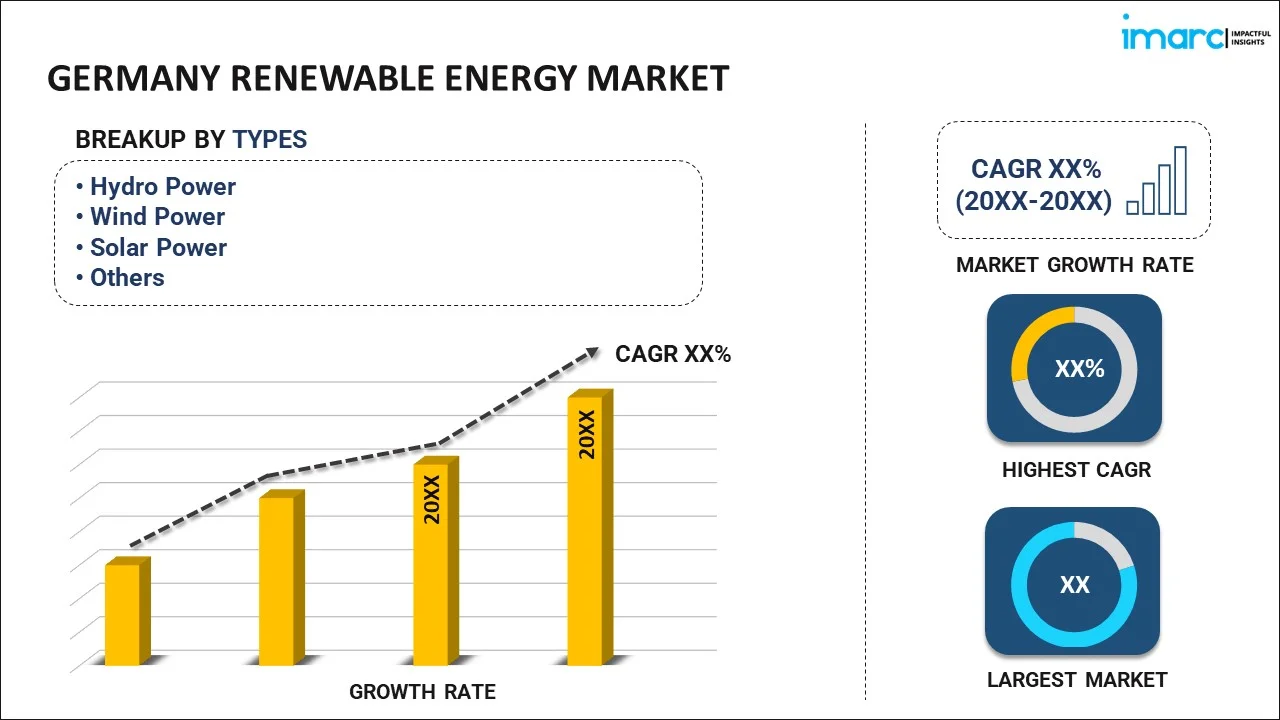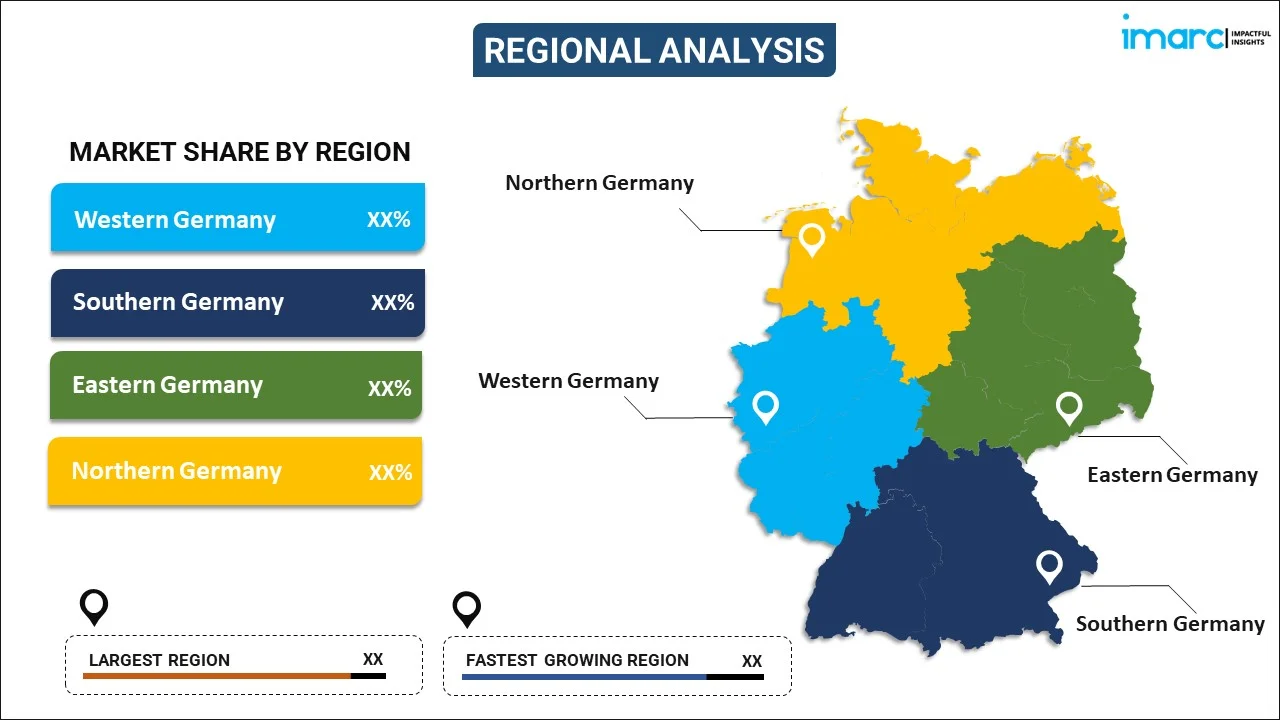
Germany Renewable Energy Market Report by Type (Hydro Power, Wind Power, Solar Power, Bioenergy, and Others), End User (Industrial, Residential, Commercial), and Region 2025-2033
Germany Renewable Energy Market Overview:
The Germany renewable energy market size reached USD 43.1 Billion in 2024. Looking forward, IMARC Group expects the market to reach USD 104.8 Billion by 2033, exhibiting a growth rate (CAGR) of 10.37% during 2025-2033. Germany’s electricity generation from renewable sources is expected to reach 288.91 billion kWh in 2025, reflecting the country's accelerating shift to clean energy. In 2023, Germany accounted for a 4.2% share of the global renewable energy market. Key growth drivers include the rising deployment of solar and wind infrastructure, supportive Germany renewable energy target policies, technological innovations, public awareness, and grid modernization. These factors, alongside evolving German energy market regulations and increased investment in renewable Germany infrastructure, are propelling long-term expansion across all segments of the Germany renewable energy market.
|
Report Attribute
|
Key Statistics
|
|---|---|
|
Base Year
|
2024
|
|
Forecast Years
|
2025-2033
|
|
Historical Years
|
2019-2024
|
| Market Size in 2024 | USD 43.1 Billion |
| Market Forecast in 2033 | USD 104.8 Billion |
| Market Growth Rate 2025-2033 | 10.37% |
Germany Renewable Energy Market Trends:
Rising Number of Solar Power Plants
According to the content published in 2023 on the website of the International Trade Administration (ITA), around 1.7 million solar power plants with a total capacity of approximately 45 GWp have been installed in Germany over the past 25 years. Solar power plants contribute to diversifying Germany's energy mix, reducing reliance on traditional fossil fuels such as coal and natural gas. This diversification enhances energy security and resilience to supply disruptions. In addition, the rising number of solar power plants increases the overall capacity of renewable energy generation in Germany. This growth is essential for meeting renewable energy targets set by the government. The expansion of solar power plants enables greater participation of people in renewable energy generation through initiatives like community solar projects and rooftop solar installations, thereby propelling the growth of the Germany solar energy market.
Besides this, the expansion of solar power plants is promoting the development of new technologies in the field of solar energy, including increased efficiency of photovoltaic panels, energy storage stations, and smart grid capabilities. These are enhancing the cost reductions and efficiency improvements in the generation of Germany renewables.
Growing Onshore and Offshore Wind Energy Capacity
Increasing the capacity of onshore and offshore wind energy helps diversify the energy mix in Germany and reduces dependency on fossil fuels like coal and natural gas. This diversification enhances energy security and energy sustainability since it relies on renewable and locally accessible resources. The country has also established certain specific objectives toward the development of onshore and offshore wind power plants. Therefore, the growth in wind energy capacity can significantly contribute to these targets in relation to renewable energy sources, ensuring that Germany remains on track to achieve its Germany renewable energy target and commitments.
In line with this, integrating onshore and offshore wind energy systems requires investment in transmission networks like lines, transformers, and gas control systems. This enhances grid flexibility and resource reliability because it provides proper integration of variable forms of renewable energy, hence contributing to market development. Wind energy, both onshore and offshore, is crucial to the efforts of Germany in addressing climate challenges and reducing greenhouse gas emissions. The International Trade Administration (ITA) outlines that by 2030, Germany should have a capacity in onshore wind energy of up to 110 GW, and over 30 GW in offshore wind energy.
Energy Transition
Germany’s Energy Transition (Energiewende) is a pivotal trend driving the country’s German Energy Market. With a strong commitment to decarbonization, Germany is accelerating its shift to renewable sources like wind and solar, aiming for a sustainable energy system. By 2024, renewables made up about 60% of electricity generation, with significant increases in solar (+16.2 GW) and wind power (+3.2 GW). The government’s 2030 targets for onshore wind (115 GW) and offshore wind (30 GW) demonstrate a clear focus on expanding renewable infrastructure. Germany renewable energy share and energy storage and grid flexibility are also key components of the Germany renewable energy market, ensuring reliable integration of variable resources. This ongoing transition supports both energy sovereignty and climate goals, positioning Germany's renewable energy as a global leader in green energy Germany.
Germany Renewable Energy Market Segmentation:
IMARC Group provides an analysis of the key trends in each segment of the market, along with forecasts at the country level for 2025-2033. Our report has categorized the market based on type and end user.
Type Insights:

To get more information on this market, Request Sample
- Hydro Power
- Wind Power
- Solar Power
- Bioenergy
- Others
The report has provided a detailed breakup and analysis of the market based on the type. This includes hydro power, wind power, solar power, bioenergy, and others.
End User Insights:
- Industrial
- Residential
- Commercial
A detailed breakup and analysis of the market based on the end user have also been provided in the report. This includes industrial, residential, and commercial.
Regional Insights:

- Western Germany
- Southern Germany
- Eastern Germany
- Northern Germany
The report has also provided a comprehensive analysis of all the major regional markets, which include Western Germany, Southern Germany, Eastern Germany, and Northern Germany.
Competitive Landscape:
The market research report has also provided a comprehensive analysis of the competitive landscape. Competitive analysis such as market structure, key player positioning, top winning strategies, competitive dashboard, and company evaluation quadrant has been covered in the report. Also, detailed profiles of all major companies have been provided.
Germany Renewable Energy Market News:
- July 2025: Skyborn Renewables and Siemens Gamesa signed a turbine supply deal for Germany’s 927 MW Gennaker offshore wind farm in the Baltic Sea. The project will deploy 103 SG 14-236 DD turbines, each with a 236-meter rotor, making it Germany’s largest offshore wind farm once operational. Expected to power nearly one million homes, Gennaker supports Germany’s climate neutrality goals. The agreement includes long-term service, ensuring efficiency and reliability.
- May 25, 2023: RWE, a Germany-based power producer announced to acquire 49% stake in Nordseecluster, a 1.6 GW cluster of offshore wind farms from Northland Power, for around Euro 37.5 million.
- May 25, 2023: German automotive giant Mercedes-Benz has unveiled plans to develop a 120MW wind farm at its test track in Papenburg, northern Germany.
Germany Renewable Energy Market Report Coverage:
| Report Features | Details |
|---|---|
| Base Year of the Analysis | 2024 |
| Historical Period | 2019-2024 |
| Forecast Period | 2025-2033 |
| Units | Billion USD |
| Scope of the Report | Exploration of Historical Trends and Market Outlook, Industry Catalysts and Challenges, Segment-Wise Historical and Future Market Assessment:
|
| Types Covered | Hydro Power, Wind Power, Solar Power, Bioenergy, Others |
| End Users Covered | Industrial, Residential, Commercial |
| Regions Covered | Western Germany, Southern Germany, Eastern Germany, Northern Germany |
| Customization Scope | 10% Free Customization |
| Post-Sale Analyst Support | 10-12 Weeks |
| Delivery Format | PDF and Excel through Email (We can also provide the editable version of the report in PPT/Word format on special request) |
Key Benefits for Stakeholders:
- IMARC’s industry report offers a comprehensive quantitative analysis of various market segments, historical and current market trends, market forecasts, and dynamics of the Germany renewable energy market from 2019-2033.
- The research report provides the latest information on the market drivers, challenges, and opportunities in the Germany renewable energy market.
- Porter's five forces analysis assist stakeholders in assessing the impact of new entrants, competitive rivalry, supplier power, buyer power, and the threat of substitution. It helps stakeholders to analyze the level of competition within the Germany renewable energy industry and its attractiveness.
- Competitive landscape allows stakeholders to understand their competitive environment and provides an insight into the current positions of key players in the mark
Key Questions Answered in This Report
The Germany Renewable Energy Market was valued at USD 43.1 Billion in 2024.
The Germany renewable energy market is projected to exhibit a CAGR of 10.37% during 2025-2033, reaching USD 104.8 Billion by 2033.
Key factors include the growing number of solar power plants, increased wind energy capacity, technological advancements, public support, and favorable policies by the German government.
Need more help?
- Speak to our experienced analysts for insights on the current market scenarios.
- Include additional segments and countries to customize the report as per your requirement.
- Gain an unparalleled competitive advantage in your domain by understanding how to utilize the report and positively impacting your operations and revenue.
- For further assistance, please connect with our analysts.
 Request Customization
Request Customization
 Speak to an Analyst
Speak to an Analyst
 Request Brochure
Request Brochure
 Inquire Before Buying
Inquire Before Buying




.webp)




.webp)












